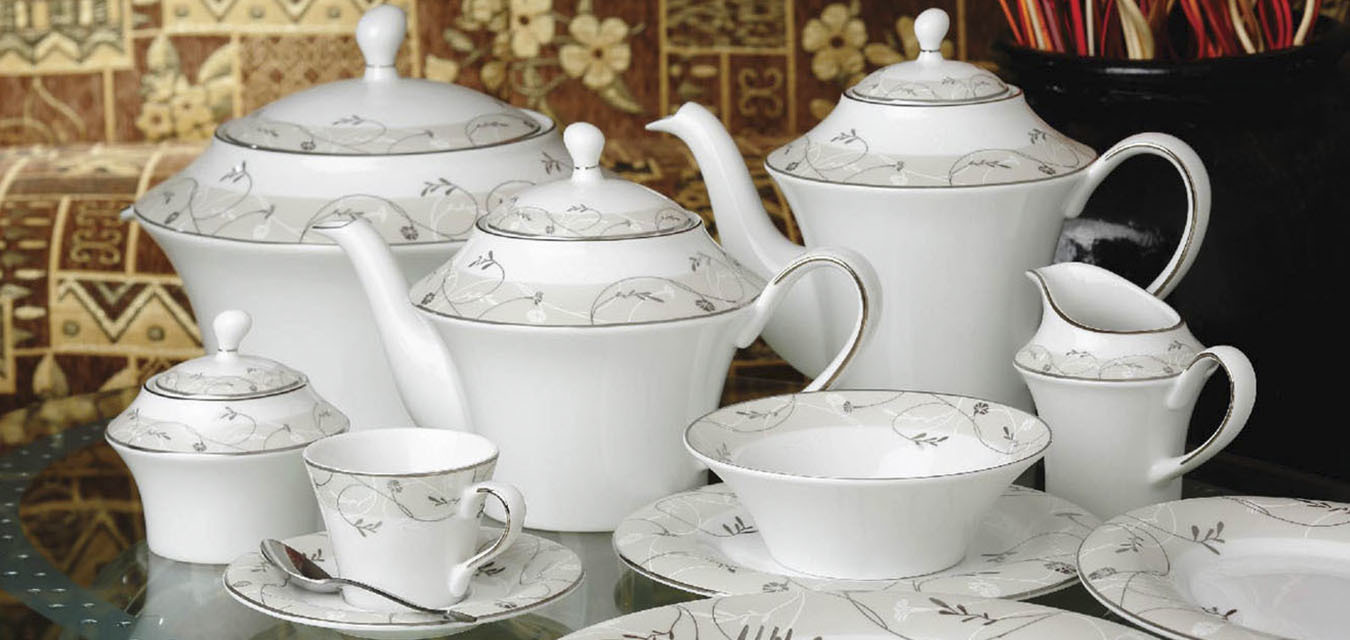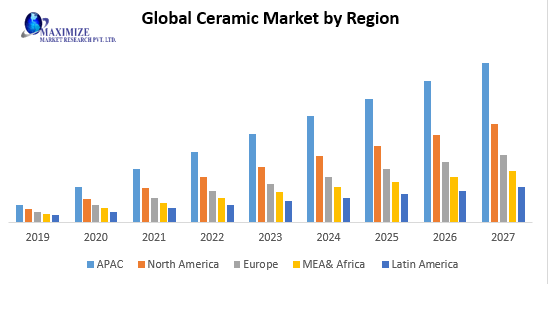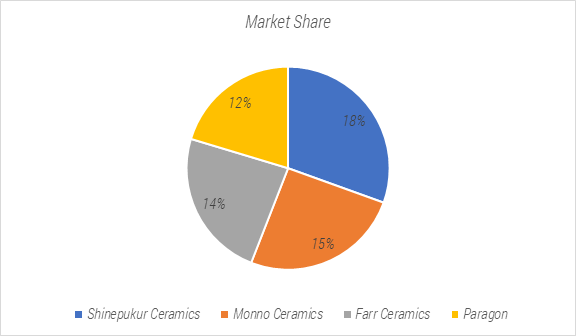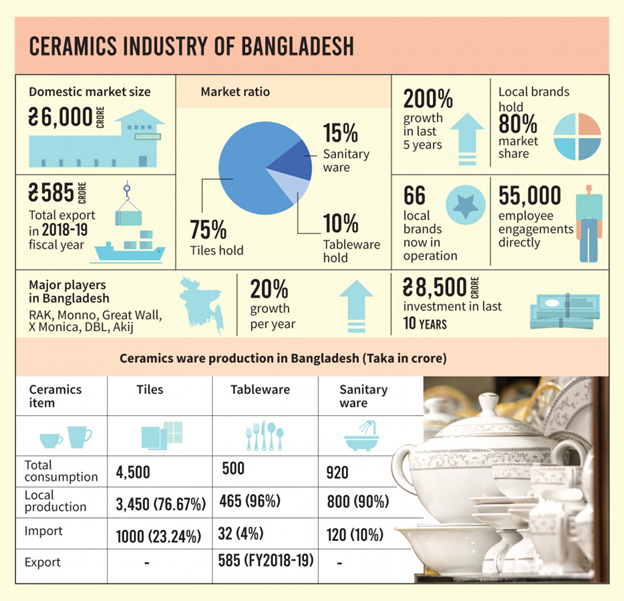GET IN TOUCH
- Please wait...

The ceramic industry has been one of the burgeoning manufacturing sectors of Bangladesh. Local demand for ceramic products continues to grow as the country experiences steady economic growth and urbanization. Not only is the industry catering to 85% of the local demand, but also serving a major portion of the export market: progressing towards being the third largest sector in the next five years.[1] Total investment amounts to BDT 86,160 million and more than 50, 000 people are directly engaged in this sector.[3] The industry that took its nascent steps in 1958 with only one small manufacturing plant in Bogra (Tajma Ceramic Industries), is now an arena of 66 local manufacturers in operation.[1]
The global market of ceramic products, according to a recent report, is predicted to be worth USD 407.72 billion by 2025.[9] The key drivers of this market growth are basically the emergence of various applications of “advanced ceramics”. For example, use of advanced ceramics in 3D printing technology and dental implants. Raw materials and energy are the major constituents of the manufacturing cost structure of ceramics. Raw materials stand at 22%, followed by energy which is responsible for 21%, labor and overhead costs at 16% and 13% respectively. The remaining percentage, 28% is attributed to transport, distribution and depreciation.[9] Manufacturers face constant criticism over energy consumption and carbon dioxide emission which is why the global market is on the pursuit of more sustainable methods of production.
The traditional ceramics product had the highest share in terms of revenue, about 59.6% in 2018. The leading segment, however, is advanced ceramics, mainly due to its biomedical applications. Asia Pacific was the region with the highest revenue, about 39.6% in 2018, driven by India and China mostly. Major players dominating the global scenario are AGC Ceramics Co.Ltd., Imerys Ceramics, Carbo Ceramics, Inc., 3M, Corning, and Kyocera Corporation.

The core products of this industry comprise tiles, tableware, and sanitary ware. The following table illustrates the annual production capacity of the local companies:
| Tableware | Tiles | Sanitaryware |
| 250 million pieces | 200 million square meters | 9 million pieces |
Total domestic market consumption for ceramic products was around BDT 54.5 billion in Fiscal Year 2017-18, of which 80% was locally produced and the rest imported.[3] To keep up with these skyrocketing figures, local companies have been amplifying their plants and operations.
The sector has also lured foreign investment mainly from China and the Middle East. These joint venture partners include RAK Ceramics, Fu Wang, and China-Bangla; the largest being RAK of the UAE, maintaining an 80% share of the local sanitary ware market. [6]

The sector earned USD 68.8 million in the fiscal year 2018-2019 through exports according to Export Promotion Bureau (EPB), making ceramics the 7th most exported item.[1] Moreover, the industry has been enjoying exponential growth in exports consistently, with about a 26% growth in the last 3 years.
Ceramic products are currently exported to more than 50 countries including the USA, Italy, Spain, France, New Zealand, the Netherlands, Australia, and Sweden. The strengths of the exports of this industry are attributed to the variety of products at competitive prices and the compliance with international quality standards.
Sector representatives stated that Bangladeshi ceramic products are earning more limelight globally, pertaining to the trade war between the US and China. Ceramic is amongst the 100 items from China that the US government has hiked tariffs on, allowing our ceramic industry to capitalize on this golden opportunity.[7] However, industry rivalry continues to thrive, with the largest rivals being China and India. The cheap labor costs however serve as a competitive advantage for our country.[6]

The Bangladesh ceramic industry has branched to a much wider array of applications, namely ‘advanced ceramics’. The value-added features of these ceramics allow them to be utilized for issues like energy conservation, water purification, and electronic and biomedical applications.
The global market for these products is experiencing a high growth momentum and is expected to reach USD 141.53 billion by 2025.[8] Bangladesh is trying to explore beyond the traditional usage of ceramics and tap into this prospective segment. Companies and universities delve deep into research and development to explore the potential of advanced ceramics.
For example, Shinepukur Ceramics Ltd is working under a government project with the GCE department to develop heat-insulating ceramic fibres for industrial applications. The company has successfully produced ceramic fibres using a pilot plant installed at BUET and plans to mass-produce them in the near future.
A low-cost ceramic water filter has also been produced by the department in collaboration with Shinepukur Ceramics. On the other hand, DBL Ceramics, with its own funding, is directing a project with the GCE department to produce solar-grade silicon wafers from quartz (sand).
While Bangladesh showcases promising advantages in this sector, there lie some inevitable issues:
An uninterrupted supply of natural gas is not only the key resource of this industry but also one of the determinants of quality standards. But insufficient supply has posed a major hindrance in this sector which is why compressed natural gas (CNG) or liquefied natural gas (LNG) is being used as a substitute, but these are not cost-effective.
Companies are heavily dependent on raw material imports mainly clay, feldspar, and quartz from overseas whereas the industry’s rivals, China, and India manufacture their own raw materials.
Companies have to bear huge amounts of costs because of supplementary duties and taxes levied on raw material imports.
Frequent spikes in gas prices cause increases in product prices owing to the fact that gas is the prime element of this industry. The fluctuations are not very well received by buyers, which is why they might opt for low-priced Chinese goods.
This industry suffers from a paucity of superior industrial engineering techniques, an adept workforce, required equipment, and an international standard laboratory for testing and quality control.
This sector, being a heavily import-oriented one, needs immediate assistance from the government in providing zero duties on imports, export incentives, and reducing supplementary duties. The RMG sector enjoys zero-duty imports and ceramic being the next potential sector should have similar opportunities for sustainable growth.
Moreover, methods that would rely on the national production of raw material production should be reinforced. For example, Mymensingh has a rich mine of white clay which can provide up to 2.57 million tons of clay, and white clay is one of the prime raw materials used for ceramic products and is still imported.[4] In addition to Chittagong, Sherpur and Netrokona districts are reported to produce surface deposits of white clay.
In order to retain local customers, manufacturers should maintain a consistent price range which in turn means that gas prices need to be stable.
Lastly, in order to bridge the yawning gap between the availability and requirement of skilled manpower in the industry, this sector is in dire need of research and development and sufficient training programs. Bangladesh should be evolving persistently in order to serve the new realm of advanced ceramics so that the industry can truly maximize its potential in no time.
Afiya Tahsin, Trainee Consultant at LightCastle Partners, has prepared the write-up. For further clarifications, contact here: [email protected].
Our experts can help you solve your unique challenges
Stay up-to-date with our Thought Leadership and Insights